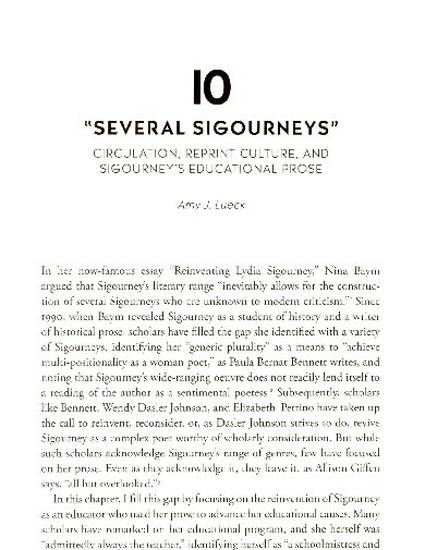
In her now-famous essay "Reinventing Lydia Sigourney," Nina Baym argued that Sigourney's literary range "inevitably allows for the construction of several Sigourneys who are unknown to modern criticism."1 Since 1990, when Baym revealed Sigourney as a student of history and a writer of historical prose, scholars have filled the gap she identified with a variety of Sigourneys, identifying her "generic plurality'' as a means to "achieve multi-positionality as a woman poet," as Paula Bernat Bennett writes, and noting that Sigourney's wide-ranging oeuvre does not readily lend itself to a reading of the author as a sentimental poetess. 2 Subsequently, scholars like Bennett, Wendy Oasler Johnson, and Elizabeth Petrino have taken up the call to reinvent, reconsider, or, as Dasler Johnson strives to do, revive Sigourney as a complex poet worthy of scholarly consideration. But while such scholars acknowledge Sigourney's range of genres, few have focused on her prose. Even as they acknowledge it, they leave it, as Allison Giffen says, "all but overlooked."3
In this chapter, I fill this gap by focusing on the reinvention of Sigourney as an educator who used her prose to advance her educational causes. Many scholars have remarked on her educational program, and she herself was "admittedly always the teacher," identifying herself as "a schoolmistress and a literary woman."4 For example, in chapter 12, Ricardo Miguel-Alfonso pays similar attention to Sigourney's didactic use of history and biography, which connects hers to the educational projects of Ralph Waldo Emerson and the other transcendentalists. In From School to Salon, Mary Loeffelholz offers perhaps the most extended attention to the centrality of schooling to Sigourney's writing and life. Loeffelholz suggests that we "consider the school as the common social location ... of Sigourney's poetic and prose genres, inseparable from their matrix of republican ideas."5 That is, she frames schooling and Sigourney's identity as a teacher-rather than the home and motherhood-as central to the writer's work "as a whole."6 In her attention to the school, Loeffelholz raises a question that is central to my own essay: "Is the authority of the teacher modeled on that of the mother, or that of the mother on the teacher?" She answers, "For Lydia Sigourney, the role of the teacher came first, nor just biographically but historically, ideologically, and almost, it seems ontologically."7 I would add that, while Sigourney positioned herself in relation to domestic culture in her early work, she developed an increasingly professional authorial persona in relation to education that drew on the authority of mothers but was increasingly distanced from the home. In other words, she spoke to maternal teachers in her earlier essays; but by the late 1830s and 1840s, as the schoolroom became an accepted site of practice for women students and teachers, she increasingly intervened in conversations about formal, extra-domestic schooling. Further, in Sigourney's broad circulation of her educational essays, we can clearly trace the evolution of her ideas about education and gender and about herself as a woman educator, which changed as the cultural terrain around women's education shifted, particularly in regard to what Loeffelholz calls the emergence of the "domestic- tutelary regime," in ways she did not always control.8

Reprinted with permission.